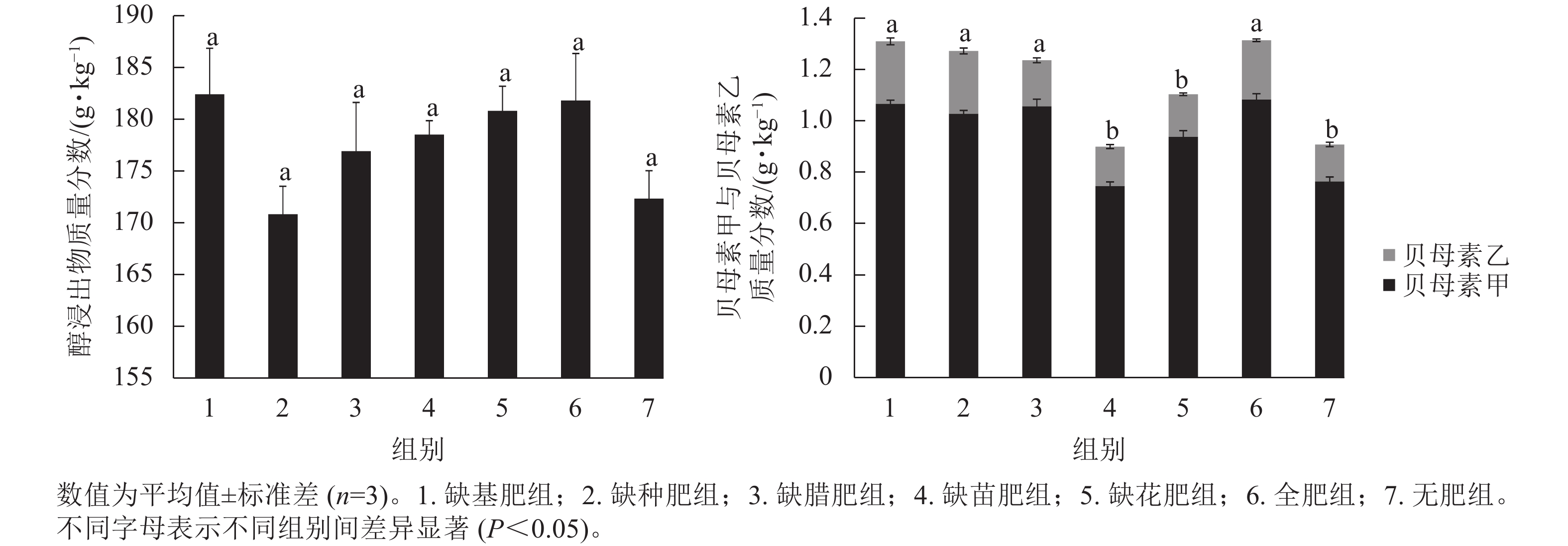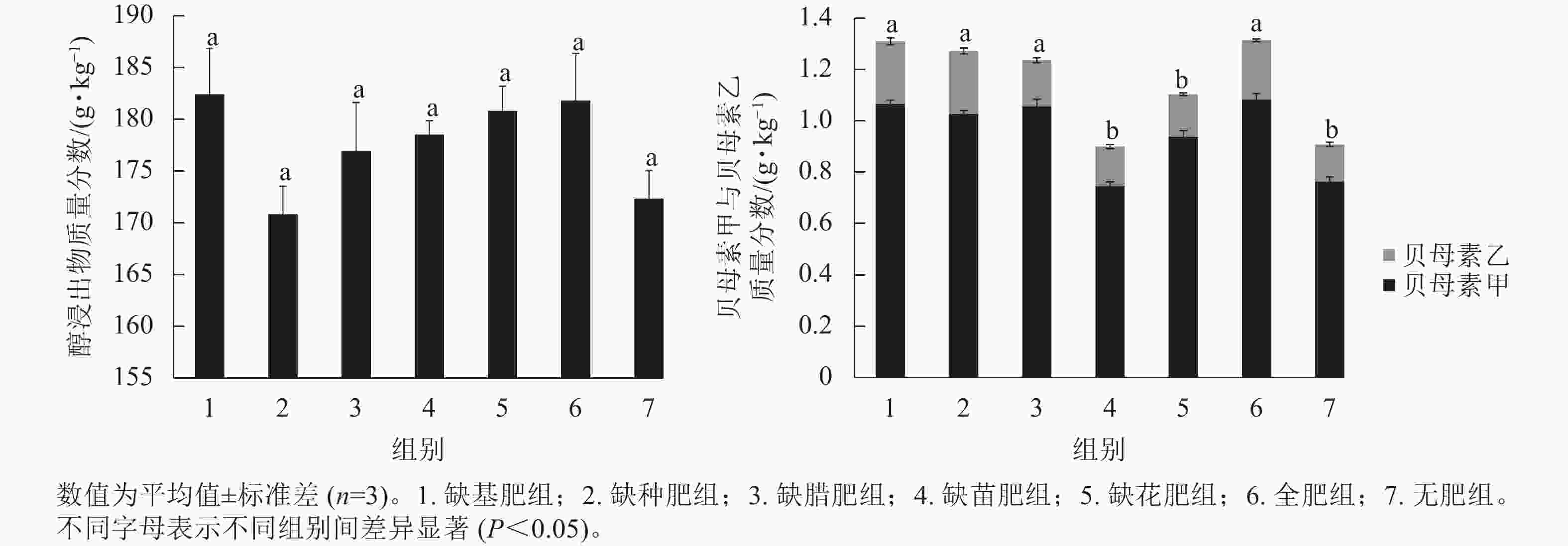-
浙贝母Fritillaria thunbergii是百合科Liliaceae贝母属Fritillaria植物,以地下鳞茎入药,具有清热化痰、解毒消痈的作用,是“浙八味”之一[1]。浙贝母在浙江道地产区种植历史悠久,是浙江省宁波市海曙区、金华市磐安县等地区的支柱产业[2],但目前浙贝母产业发展中存在农户分散种植以及过量使用化肥的现象[3]。过度施肥会导致浙贝母的品质无法得到保证,过量的化肥不仅增加生产成本,还将造成水源污染、土壤板结、土传病害加重等危害,影响种植产业的可持续发展[4−5]。2020年出台了浙江省地方标准《浙贝母绿色生产技术规范》[6],对规范浙贝母不同生育期的施肥措施起到了推进作用,有助于保证浙贝母的高产和优质。已有研究表明:不同类型的肥料可以导致浙贝母药材产量和品质的变化。全硝、全铵的氮肥施用均不利于浙贝母生长[7],重过磷酸钙比钙镁磷肥对浙贝母生长促进作用更大[8],钾肥能提高全株生物量积累并推迟倒苗时间,促进增产[9−10]。但不同生育期施肥对浙贝母产量和品质的影响还未见系统报道。鉴于此,本研究以品种‘浙贝3号’‘Zhebei 3’为研究对象,设置不同生育期减少施肥处理,研究各生育期缺肥对浙贝母产量和品质指标的影响,进而明确浙贝母不同生育期的需肥特征,为实现浙贝母减肥不减产、减肥不减质的生态栽培提供理论依据。
-
‘浙贝3号’种鳞茎选自浙江省宁波市章水镇浙贝母栽培种植基地。2021年10月15日选取质量为(6.86±0.92) g,直径为(2.83±0.23) cm,高度为(2.05±0.31) cm,完好健壮的种鳞茎种在直径25 cm,高25 cm的纺布袋花盆中。盆中土壤由沙土与腐殖土混合均匀,质量比为1∶1,每盆质量约8 kg,基本理化性质:pH 7.60~7.70,全氮为(2.50±0.02) g·kg−1,有效磷为(66.78±1.33) mg·kg−1,速效钾为(26.36±0.60) mg·kg−1,有机质为(16.16±0.39) g·kg−1。
-
盆栽试验每盆均匀种4个鳞茎,分基肥、种肥、腊肥、苗肥、花肥5个时期施肥,依次少施1种肥料,并设置施全肥对照和空白对照,共7组:组1,缺基肥(缺失时间2021年10月15日);组2,缺种肥(2021年10月15日);组3,缺腊肥(2021年12月15日);组4,缺苗肥(2022年3月5日);组5,缺花肥(2022年3月25日);组6,全肥;组7,无肥。每组12盆。每盆施用量根据《浙贝母绿色生产技术规范》[6]换算,‘浙贝3号’种植行距约19 cm,株距约19 cm,排除沟壑田垄等占用面积,1 hm2种鳞茎约24万株,计算平均值得到每盆4株施肥量:基肥(商品有机肥100 g·盆−1),种肥(商品有机肥50 g·盆−1,钙镁磷肥10 g·盆−1),腊肥(氮磷钾复合肥3 g·盆−1),苗肥(氮磷钾复合肥6 g·盆−1,硫酸钾1 g·盆−1),花肥(尿素1 g·盆−1,硫酸钾1 g·盆−1)。浇水、摘花打顶等栽培管理措施按技术规范实施。有机肥(质量分数有机质≥45%,氮磷钾≥4%),钙镁磷肥(质量分数五氧化二磷≥12%,氧化钙≥20%,氧化锰≥3%,二氧化硅≥10%,pH为7~10),氮磷钾复合肥(质量分数氮≥15%,五氧化二磷≥15%,氧化钾≥15%),尿素(氮质量分数≥46%)。
于‘浙贝3 号’不同生育期天气晴朗的10: 00,选择每组中长势中等的1盆,挖出所有单株,测定形态指标,分别取健康叶片和鳞茎用于测定。
-
5月上旬倒苗后,挖出鳞茎,去除残留地上部分、杂质、泥土,洗净。统计每盆中鳞茎总鲜质量,切片,60 ℃烘干,记录总干质量,计算折干率。制备样品粉末,过3号筛备用。
-
醇浸出物和贝母素甲、贝母素乙检测参考郎晓平[10]等的方法。
-
每组以有50%单株幼苗的芽尖出土日期记为出苗时间,以有10%单株开花日期记为始花时间,以有50%单株主杆枯黄日期记为倒苗时间。以有单株芽尖出土到全部单株芽尖出土时间段记为出苗期,以有单株开花到有单株主杆枯黄时间段记为花期,出苗期到花期之间时间段记为苗期,花期之后到采收前时间段记为倒苗期。株高为鳞茎到主杆顶部生长点长度,叶片长宽为基部倒数第3对叶片长宽。将植株洗净擦干,从主杆底部剪开,去除须根,分别称取地上部分鲜质量和地下部分鲜质量。
-
叶绿素相对含量用SPAD叶绿素计测定,每株选择顶端向下第4片叶。可溶性糖质量分数用硫酸苯酚法测定。丙二醛(MDA)质量摩尔浓度、过氧化物酶(POD)活性、过氧化氢酶(CAT)活性、超氧化物歧化酶(SOD)活性根据试剂盒说明书测定。另测定鲜品含水量,折算干质量。
-
称取适量植物组织,加浓硫酸、过氧化氢,380 ℃消煮2 h,定容至100 mL作为待测液测定氮磷钾。氮质量分数用半微量凯氏定氮法。磷质量分数用钼锑抗比色法。钾质量分数用原子吸收光谱法[11]。
-
采用Excel 2016和SPSS 26.0进行数据统计分析,运用单因素方差分析法(ANOVA)和多重比较法(Duncan)进行差异显著性分析,运用皮尔逊法(Pearson)计算相关系数。
-
由表1可见:缺基肥、种肥、腊肥处理的总鲜质量、总干质量、折干率与全肥处理相比均无显著差异;缺苗肥、花肥处理相比全肥处理总鲜质量分别显著降低16.44%、19.08%(P<0.05),总干质量分别显著降低19.15%、21.58% (P<0.05)。可见,缺失基肥、种肥、腊肥对‘浙贝3号’鳞茎质量无显著影响,不会造成减产;缺失苗肥、花肥会显著降低鳞茎质量,造成减产。
组别 总鲜质量/g 总干质量/g 折干率/% 缺基肥 59.91±2.07 a 16.95±0.55 a 28.30±0.30 a 缺种肥 58.79±1.92 a 16.66±0.56 a 28.35±0.33 a 缺腊肥 56.99±1.36 a 16.14±0.34 a 28.32±0.20 a 缺苗肥 50.97±1.76 b 13.97±0.55 b 27.40±0.32 b 缺花肥 49.36±3.19 b 13.55±0.91 b 27.44±0.33 b 全肥 61.00±2.47 a 17.28±0.80 a 28.32±0.26 a 无肥 38.85±1.83 c 10.66±0.53 c 27.43±0.31 b 说明:数值为平均值±标准差(n=3)。同列不同字母表示组别间差异显著(P<0.05)。 Table 1. Yields of newborn bulb of ‘Zhebei 3’ in different treatment groups during harvesting stage
-
不同施肥处理组的新生鳞茎醇浸出物质量分数为17.08%~18.24%,均无显著差异。缺基肥、种肥、腊肥处理下,贝母素甲与贝母素乙质量分数总量略低于全肥处理,但均无显著差异;缺苗肥、花肥处理相比全肥处理分别显著降低了30.76%、15.38% (P<0.05),其中贝母素甲质量分数分别降低了30.55%、12.96%,贝母素乙质量分数分别降低了34.78%、26.08% (P<0.05)(图1)。可见,缺失基肥、种肥、腊肥对‘浙贝3号’品质无显著影响,缺失苗肥、花肥会显著降低‘浙贝3号’生物碱质量分数,影响品质。
-
由表2可见:相比全肥处理,缺基肥、种肥、腊肥处理的出苗时间分别推迟6、5、5 d,苗期株高分别显著降低了14.5%、12.5%、10.6%(P<0.05),地上部分鲜质量分别显著降低了29.6%、23.3%、26.4%(P<0.05)。缺基肥、种肥、腊肥处理的花期株高、地上部分鲜质量略低于全肥处理,且均无显著差异。缺基肥、种肥、腊肥处理的倒苗期株高、地上部分鲜质量、地下部分鲜质量与全肥处理均无显著差异,倒苗时间分别提前2、3、3 d。
物候期 组别 物候期时间
(年-月-日)株高/cm 叶片长/cm 叶片宽/cm 地上部分鲜质量/g 地下部分鲜质量/g 苗期 1 2022-02-09 8.57±0.57 b 6.31±0.82 b 1.13±0.06 b 9.27±1.46 b 4.02±0.31 a 2 2022-02-08 8.77±0.71 b 6.42±0.98 b 1.14±0.15 b 10.10±1.56 b 4.07±0.21 a 3 2022-02-08 8.96±0.75 b 6.43±0.51 b 1.02±0.09 b 9.68±0.42 b 4.21±0.26 a 4 2022-02-03 10.20±1.01 a 6.83±0.35 ab 1.13±0.06 b 12.51±1.08 a 4.22±0.70 a 5 2022-02-04 9.43±0.93 ab 6.93±0.45 a 1.27±0.06 a 11.43±3.59 ab 4.29±0.31 a 6 2022-02-03 10.02±0.56 a 7.17±0.74 a 1.23±0.06 a 13.17±2.66 a 4.27±0.31 a 7 2022-02-09 6.57±0.15 c 5.63±0.45 c 1.03±0.06 b 7.83±0.46 c 3.84±0.41 b 花期 1 2022-03-14 12.49±0.81 a 8.03±0.21 a 1.33±0.06 a 16.33±2.12 a 5.65±0.52 a 2 2022-03-15 13.77±0.85 a 8.12±0.26 a 1.30±0.12 a 16.27±2.84 a 5.61±0.31 a 3 2022-03-14 13.61±0.88 a 8.09±0.35 a 1.31±0.17 a 17.30±0.52 a 5.88±1.51 a 4 2022-03-16 13.28±1.18 a 6.67±0.32 b 1.15±0.06 b 12.18±1.75 b 5.03±0.93 b 5 2022-03-14 13.57±0.91 a 7.93±0.15 a 1.27±0.06 a 15.63±3.07 a 5.67±1.12 a 6 2022-03-15 13.87±0.84 a 8.13±0.21 a 1.31±0.13 a 17.53±2.96 a 6.22±1.51 a 7 2022-03-17 11.21±0.35 b 6.03±0.21 c 1.08±0.06 b 11.47±0.31 b 4.73±0.31 b 倒苗期 1 2022-04-16 11.82±0.59 a 10.03±0.57 a 1.70±0.23 a 12.63±2.57 b 10.37±0.35 a 2 2022-04-15 12.71±2.10 a 9.57±1.16 a 1.57±0.21 a 15.67±2.54 a 10.47±1.76 a 3 2022-04-15 10.93±1.59 ab 8.95±0.57 ab 1.72±0.11 a 11.37±0.81 b 10.83±1.10 a 4 2022-04-11 10.43±1.81 b 7.57±1.10 b 1.31±0.17 b 4.22±0.98 c 8.21±0.26 b 5 2022-04-16 10.23±1.46 b 8.37±1.07 b 1.53±0.12 a 11.67±3.31 b 8.77±0.25 b 6 2022-04-18 11.23±0.42 a 9.37±0.83 a 1.70±0.12 a 14.37±4.80 a 11.27±1.63 a 7 2022-04-10 10.17±0.85 b 7.79±0.61 b 1.67±0.06 a 5.02±2.36 c 6.93±0.12 c 说明:数值为平均值±标准差(n=3)。1. 缺基肥组;2. 缺种肥组;3. 缺腊肥组;4. 缺苗肥组;5. 缺花肥组;6. 全肥组;7. 无肥组。同时期各列不同小写字母表示不同组别间显著差异(P<0.05)。 Table 2. Morphological indexes of ‘Zhebei 3’ in different phenological stages in different treatment groups
相比全肥处理,缺苗肥处理的苗期各项形态指标均无显著差异;花期叶片长度降低了17.9%、宽度降低了12.2%,地上部分鲜质量降低了30.5%,均有显著差异(P<0.05);倒苗时间提前7 d,地上部分鲜质量降低了70.6%,地下部分鲜质量降低了27.1%,均有显著差异(P<0.05)。
相比全肥处理,缺花肥处理的花期和倒苗期各项形态指标均无显著差异,倒苗时间提前了2 d,可能由于在花期‘浙贝3号’形态生长已经完成,地上部分受缺肥影响较小,但是地下部分鲜质量显著降低了22.1%(P<0.05)。
-
由表3可见:在苗期,缺基肥、种肥、腊肥处理的叶片可溶性糖质量分数、叶绿素相对含量显著低于全肥处理(P<0.05),缺苗肥、花肥处理与全肥处理无显著差异。在花期,缺基肥、种肥、腊肥、花肥处理的叶片可溶性糖质量分数、叶绿素相对含量低于全肥处理,但无显著差异,缺苗肥处理的叶片可溶性糖质量分数、叶绿素相对含量显著低于全肥处理(P<0.05)。在苗期和花期,缺苗肥处理的叶片均是丙二醛质量摩尔浓度显著低于全肥处理、过氧化物酶活性显著高于全肥处理(P<0.05),缺基肥、种肥、腊肥、花肥处理的叶片丙二醛质量摩尔浓度、过氧化物酶活性与全肥处理均无显著差异。
组别 叶绿素相对含量 鳞茎鲜质量/g 出苗期 苗期 花期 倒苗期 出苗期 苗期 花期 倒苗期 1 36.67±1.04 b 50.32±1.84 b 55.60±1.90 a 38.96±2.24 a 6.60±1.73 a 4.02±0.31 a 5.75±0.50 a 10.37±1.35 a 2 38.53±1.75 b 52.14±1.71 b 56.20±2.06 a 34.90±1.43 a 7.07±0.91 a 4.07±0.21 a 5.81±0.31 a 10.47±1.76 a 3 36.26±0.86 b 51.03±1.47 b 55.83±1.26 a 33.45±1.36 a 6.27±1.10 a 4.21±0.26 a 5.88±1.50 a 10.83±1.10 a 4 44.16±1.98 a 54.14±1.15 a 50.86±1.38 b 11.36±0.86 c 6.93±0.74 a 4.22±0.70 a 5.03±0.93 a 6.20±0.26 b 5 42.96±1.78 a 55.60±1.90 a 60.80±1.70 a 21.93±1.21 b 6.00±0.62 a 4.29±0.31 a 5.67±1.12 a 7.77±0.25 b 6 41.43±1.66 a 55.13±1.96 a 61.23±1.52 a 36.96±1.58 a 7.10±0.98 a 4.27±0.31 a 6.22±1.51 a 11.26±1.63 a 7 36.46±1.00 b 47.55±1.68 c 48.77±1.94 b 11.20±0.89 c 6.73±0.40 a 3.84±0.40 a 4.73±0.31 b 5.93±0.12 b 组别 叶片可溶性糖质量分数/(g·kg−1) 鳞茎可溶性糖质量分数/(g·kg−1) 出苗期 苗期 花期 倒苗期 出苗期 苗期 花期 倒苗期 1 179.88±2.52 b 240.41±5.87 b 295.36±4.54 a 118.14±2.33 a 449.07±6.05 a 285.42±6.41 a 341.38±3.60 a 254.33±3.28 a 2 168.03±2.62 b 246.75±6.47 b 306.44±4.04 a 126.94±2.30 a 453.40±7.33 a 290.44±4.85 a 344.49±5.25 a 269.27±3.47 a 3 184.23±2.48 b 251.44±6.38 b 311.25±5.56 a 127.31±2.83 a 451.28±5.82 a 297.07±6.30 a 352.31±4.41 a 275.97±4.24 a 4 201.15±4.11 a 285.43±4.75 a 232.14±3.04 b 68.20±2.08 b 452.57±4.96 a 303.36±6.87 a 316.78±4.19 a 200.74±2.36 b 5 205.67±3.16 a 295.17±5.23 a 285.63±4.95 a 87.93±2.48 b 456.82±6.74 a 308.43±5.32 a 353.04±4.79 a 243.80±3.62 b 6 211.14±3.34 a 280.06±6.64 a 318.72±6.81 a 139.53±3.66 a 454.64±5.96 a 310.15±3.86 a 367.84±6.82 a 291.73±5.92 a 7 156.25±3.10 b 168.44±4.75 c 172.91±3.47 c 55.52±1.19 b 453.07±6.01 a 228.51±5.62 b 270.92±3.26 c 188.13±3.25 c 组别 叶片丙二醛质量摩尔浓度/(nmol·g−1) 鳞茎丙二醛质量摩尔浓度/(nmol·g−1) 出苗期 苗期 花期 倒苗期 出苗期 苗期 花期 倒苗期 1 714.07±12.78 b 466.12±5.55 a 529.45±8.55 a 320.35±4.39 a 36.43±1.25 a 47.46±1.45 b 53.57±0.68 b 33.86±1.12 b 2 761.60±12.12 a 452.33±6.96 a 537.11±6.32 a 290.52±6.53 a 39.17±0.78 a 45.33±0.95 b 54.83±0.95 b 38.03±1.64 b 3 748.54±15.09 a 479.50±6.84 a 541.37±7.48 a 297.21±5.18 a 37.15±1.09 a 46.27±0.98 b 55.62±0.88 b 41.30±1.25 b 4 721.13±14.69 ab 342.67±6.22 b 381.24±8.11 b 125.86±3.03 c 37.04±0.71 a 78.76±1.47 a 89.87±1.96 a 52.31±1.67 a 5 733.41±12.02 a 492.66±7.63 a 504.27±6.84 a 221.84±4.95 b 35.31±0.80 a 50.51±0.96 b 58.41±1.04 b 31.82±1.48 b 6 752.14±11.13 a 485.76±7.14 a 559.37±9.36 a 336.36±4.69 a 36.74±1.12 a 49.01±1.58 b 56.89±0.94 b 38.93±1.74 b 7 715.45±13.07 b 306.52±5.64 b 341.36±8.51 b 143.35±3.51 c 35.75±0.85 a 91.51±2.02 a 103.81±1.94 a 56.58±1.10 a 组别 叶片过氧化物酶活性/(×16.67 nkat·g−1) 鳞茎过氧化物酶活性/(×16.67 nkat·g−1) 出苗期 苗期 花期 倒苗期 出苗期 苗期 花期 倒苗期 1 1853.04±41.14 b 3428.67±79.58 b 3880.50±57.32 b 3122.87±71.50 b 3619.02±55.33 a 2213.13±43.64 b 2847.53±48.46 b 2215.36±55.41 b 2 2033.96±56.13 a 3541.51±73.51 b 3925.63±62.73 b 3241.25±89.35 b 3557.44±90.46 a 2193.96±77.62 b 2876.11±38.71 b 2067.57±35.66 b 3 1990.24±61.95 a 3688.14±65.77 b 4042.05±55.72 b 3098.46±53.41 b 3694.84±82.71 a 2311.14±33.45 b 2759.69±51.21 b 2133.57±60.25 b 4 2189.62±49.40 a 4169.74±64.14 a 4744.35±54.87 a 4112.76±44.17 a 3742.58±50.20 a 3578.09±46.69 a 3940.33±46.87 a 3114.54±57.05 a 5 2075.67±27.95 a 3543.68±120.37 b 3931.21±74.52 b 3647.35±47.68 b 3666.62±46.63 a 2410.03±74.02 b 2764.30±43.71 b 2258.66±33.14 b 6 2131.95±54.44 a 3774.36±64.79 b 3883.31±68.43 b 3314.21±55.88 b 3549.29±37.67 a 2294.98±77.57 b 2944.33±48.74 b 2314.54±28.41 b 7 1889.34±67.76 b 4436.78±75.35 a 5066.54±70.60 a 4364.28±68.74 a 3694.04±46.79 a 3231.13±72.29 a 3591.90±39.64 a 3041.80±39.43 a 说明:数值为平均值±标准差(n=3)。1. 缺基肥组;2. 缺种肥组;3. 缺腊肥组;4. 缺苗肥组;5. 缺花肥组;6. 全肥组;7. 无肥组。同时期同列不同字母表示不同组别间差异显著(P<0.05)。 Table 3. Characteristics of leaf and bulb physiological indexes of ‘Zhebei 3’ in different phenological stages in different treatment groups
在苗期,各处理组的新生鳞茎刚开始生长,鲜质量、可溶性糖质量分数无显著差异。在花期,缺苗肥处理的新生鳞茎鲜质量、可溶性糖质量分数最低,与全肥处理无显著差异。在苗期和花期,缺苗肥处理的新生鳞茎丙二醛质量摩尔浓度、过氧化物酶活性均最高,与全肥处理均存在显著差异(P<0.05),缺基肥、种肥、腊肥、花肥处理的新生鳞茎丙二醛质量摩尔浓度、过氧化物酶活性与全肥处理均无显著差异。
-
由表4可见:采收期鳞茎的产量、生物碱质量分数与花期叶片的叶绿素、可溶性糖、丙二醛、过氧化氢酶、超氧化物歧化酶均呈极显著正相关(P<0.01),与过氧化物酶活性呈极显著负相关(P<0.01);与花期鳞茎的可溶性糖质量分数呈极显著正相关(P<0.01),与丙二醛质量摩尔浓度、超氧化物酶活性均呈极显著负相关(P<0.01)。可能由于花期主要为3月下旬至4月上旬,此时气温逐渐升高,叶片受到高温、高光照强度的胁迫,积累一定量丙二醛,通过提高过氧化物酶活性响应胁迫,分解丙二醛,保护细胞膜,但是此时气温、光照条件更有利于叶片光合作用,所以采收期鳞茎的产量、生物碱与叶片丙二醛呈正相关,与过氧化氢酶活性呈负相关。
生育期 指标 产量 生物碱 生育期 指标 产量 生物碱 花期叶片 叶绿素 0.720** 0.694** 花期鳞茎 可溶性糖 0.892** 0.799** 可溶性糖 0.948** 0.923** 丙二醛 −0.855** −0.917** 丙二醛 0.883** 0.942** 过氧化物酶 −0.601** −0.845** 过氧化物酶 −0.855** −0.905** 过氧化氢酶 −0.292 0.108 过氧化氢酶 0.652** 0.851** 超氧化物歧化酶 0.163 0.138 超氧化物歧化酶 0.539* 0.704** 说明: *表示显著相关(P<0.05),**表示极显著相关(P<0.01)。 Table 4. Correlation analysis of physiological indexes of ‘Zhebei 3’ in flowering stage with yield and quality indexes in harvesting stage
-
由表5可见:缺基肥、种肥、腊肥和全肥处理的新生鳞茎氮质量分数无显著差异,但显著高于其他处理和种鳞茎(P<0.05)。缺基肥、全肥处理的新生鳞茎磷质量分数最高,显著高于其他处理(P<0.05),但仍比种鳞茎降低了约18%(P<0.05)。新生鳞茎钾质量分数除无肥组,各处理之间无显著差异,显著高于种鳞茎(P<0.05)。由鳞茎的大量元素积累特征和施肥时间可知:氮的积累主要发生在苗期和花期,磷的积累在种鳞茎萌发时就已经开始,而鳞茎钾的积累受缺肥影响不显著,可能是因为本研究中土壤钾质量分数能满足‘浙贝3号’生长发育的需要。新生鳞茎的质量普遍小于种鳞茎,可能是因为种鳞茎在栽培过程中施肥措施或肥料种类与本研究不同,说明磷吸收积累不足可能是限制本研究‘浙贝3号’鳞茎膨大的重要因素。
组别 氮/(mg·g−1) 磷/(mg·g−1) 钾/(mg·g−1) 组别 氮/(mg·g−1) 磷/(mg·g−1) 钾/(mg·g−1) 0 63.76±1.10 b 46.72±0.28 a 101.51±0.88 b 4 60.39±1.72 b 18.65±0.26 c 112.66±0.94 ab 1 91.91±0.98 a 36.33±0.22 b 124.26±1.59 a 5 62.04±0.63 b 20.02±0.30 c 116.36±2.09 a 2 98.44±0.43 a 26.13±0.23 c 117.64±1.38 a 6 96.24±1.55 a 37.99±0.59 b 126.19±0.86 a 3 90.76±1.19 a 21.40±0.14 c 123.35±1.27 a 7 61.16±1.05 b 16.51±0.17 c 99.57±0.84 b 说明:数值为平均值±标准差(n=3)。0. 种鳞茎;1. 缺基肥组;2. 缺种肥组;3. 缺腊肥组;4. 缺苗肥组;5. 缺花肥组;6. 全肥组;7. 无肥组。不同字母表示不同组别间差异显著(P<0.05)。 Table 5. Content of nitrogen, phosphorus and potassium in seed bulbs and newborn bulbs in different treatment groups
-
产量是药用植物生产过程中最直接的追求,品质则是中药疗效的保证。浙贝母生育期较短,增加施肥是人工栽培药用植物过程中提高产量和品质的重要手段,但不合理的施肥会对产量和品质造成影响[12−14],同时,也有研究表明:生产过程中适度减少施肥有利于提升作物品质[15−17]。
本研究发现:出苗前缺失基肥、种肥、腊肥的处理,‘浙贝3号’植株表现为出苗晚、生长发育迟缓,但经过苗期、花期追肥,花期植株的形态指标与全肥处理均无显著差异,倒苗期‘浙贝3号’的产量和品质指标与全肥处理均无显著差异,即可适当减少出苗前基肥、种肥、腊肥的用量。缺失苗肥、花肥的处理,最终‘浙贝3号’的产量和生物碱质量分数均显著降低,所以苗期、花期是产量、品质形成的关键时期,不能减少施肥。
叶绿素相对含量影响植物的同化速率,可溶性糖作为初生代谢产物,广泛存在并参与到生物碱的合成途径中[18],最终以淀粉的形式储存在鳞茎中形成产量。本研究中,缺苗肥、花肥处理会导致‘浙贝3号’生长发育的差异,表现为叶绿素相对含量和可溶性糖质量分数降低,倒苗期提前,最终导致产量和品质降低。而次生代谢是一个复杂的过程,初生代谢产物不足以直接影响生物碱质量分数。一定程度的胁迫使植物细胞内活性氧积累,产生大量膜脂过氧化产物丙二醛,植物通过增加过氧化物酶、超氧化物歧化酶、过氧化氢酶等抗氧化酶活性,分解活性氧,防止细胞膜过氧化[19−20],促进物质合成更多地流向次生代谢[21],如遮阴条件下,重楼Paris polyphylla中重楼皂苷与丙醛、超氧化物歧化酶、过氧化物酶呈极显著负相关[22]。本研究中,同样环境条件下,缺苗肥处理组过氧化物酶活性显著提高,鳞茎丙二醛质量摩尔浓度显著提高,且采收期产量、生物碱质量分数显著降低,表明苗期缺肥会降低抗逆性,不利于浙贝母生长发育。本研究结果与吴海平等[23]研究毛竹Phyllostachys edulis不同部位浸提液对浙贝母生长和生理影响的结果不同,可能是由于施肥的影响大于化感作用的影响。
‘浙贝3号’对氮肥的吸收积累从春季苗期开始,对磷肥的吸收积累则更早,从冬季出苗前便开始,而对钾肥的吸收积累各时期差异不显著,因此栽培过程中应注意调整不同时期施用肥料的元素组成[24]。全肥处理组种鳞茎的质量高于新生鳞茎,新生鳞茎的氮、钾质量分数显著高于种鳞茎,新生鳞茎的磷质量分数显著低于种鳞茎,即‘浙贝3号’对无机磷肥的吸收能力较弱,可以尝试其他形式的磷肥,以提高磷肥利用率。所以不同类型肥料施用对于浙贝母品质的影响需要进一步研究。
-
本研究显示:出苗前基肥、种肥、腊肥缺失处理对浙贝母鳞茎的产量、生物碱质量分数影响不显著;苗期、花期缺肥会导致浙贝母鳞茎显著减产,生物碱质量分数显著降低。不同生育期缺肥处理对浙贝母产量、品质的影响从大到小依次为苗肥、花肥、腊肥、种肥、基肥。综合分析,生育前期可以适当减少施肥;苗期和花期适当追肥有利于提高浙贝母产量,而不影响其品质。
Effects of fertilization at different growth stages on yield and quality of Fritillaria thunbergii
doi: 10.11833/j.issn.2095-0756.20220613
- Received Date: 2022-09-23
- Accepted Date: 2023-01-07
- Rev Recd Date: 2022-12-31
- Available Online: 2023-07-13
- Publish Date: 2023-08-20
-
Key words:
- Fritillaria thunbergii /
- growth stages /
- fertilization /
- yield /
- quality
Abstract:
| Citation: | ZHOU Shuideng, SUN Jian, JIANG Jianming, et al. Effects of fertilization at different growth stages on yield and quality of Fritillaria thunbergii[J]. Journal of Zhejiang A&F University, 2023, 40(4): 756-764. DOI: 10.11833/j.issn.2095-0756.20220613 |











 DownLoad:
DownLoad: